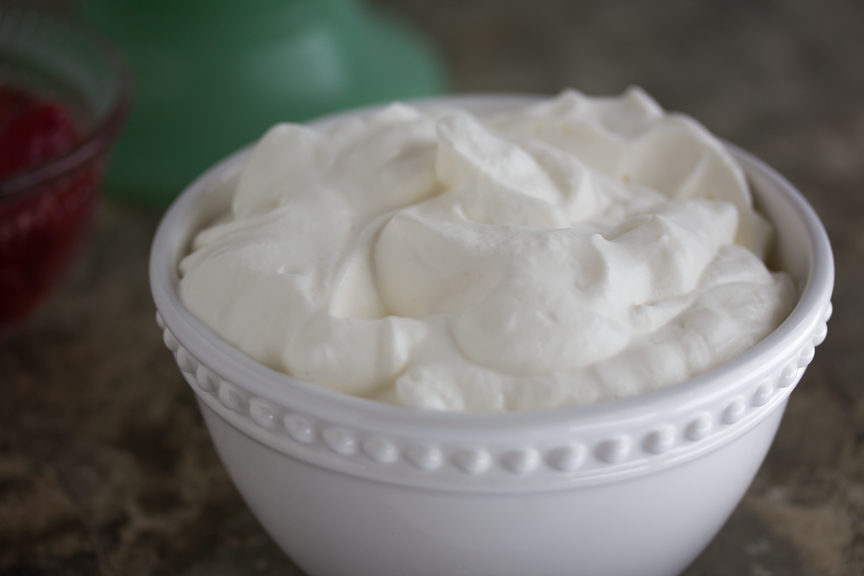Ditch the Can
Perfectly whipped cream is soft and luxurious, while overly whipped cream lacks most of those potential textural delights, so knowing how to properly whipped cream is important.
You know how “whipped” cream out of a can has that cottage cheesy look to it? Not good. It is overly agitated and the creaminess is lost in that too firm texture.
And besides, whipping cream is easy and if you make it from scratch you can control the quality of cream as well.
As Always, Serving Sizes Count
Note that the Monash University Smartphone App states that Whipped Cream is Green Light low FODMAP in a ½ cup, 125 ml serving (60 g).
How the heck can it be lactose-free? It is all about the levels of FODMAPs in the servings size, folks, so heed those recommendations.
Please read our article All About Cream & FODMAPs for much more information on the fat content of various creams and their FODMAP content. The article also compares terminology for creams in the U.S., UK and Australia.
And So Does Texture
Beyond being luscious on the tongue when eaten as is, if you are folding whipped cream into a recipe, such as a Chocolate Mousse, the texture of the whipped cream will affect the texture of the finished dish, and softly whipped cream is often called for (always follow the directions in a particular recipe).
The problem is usually that it has been over whipped, so we will be asking you to use caution and your eyes to help assess “doneness”.
This whipped cream recipe can be halved or doubled as needed, just watch your Monash servings amounts, which should not exceed ½ cup (125 ml) per person per serving – which is very generous, so feel free to indulge on occasion.
Stabilized Whipped Cream
Sometimes you need whipped cream to hold up, such as when you are topping a pie well ahead of serving. There are two ways we like to accomplish this: one is a less technical approach that improves holding power somewhat and the other is more reliable and can even last 24 hours if refrigerated. See Tips for our approach using gelatin.

Whipped Cream
Whipped Cream can be enjoyed on the low FODMAP diet if used in moderation. Stick with a ½ cup (60 g) portion.
Ingredients:
- 2 1/2 cups whipping cream or heavy cream, chilled
- 5 tablespoons sugar or sifted confectioners’ sugar (see Tips)
- 1/2 teaspoon vanilla extract; optional
Preparation:
-
In a chilled bowl, beat cream, sugar and vanilla (if using) on medium-high speed with an electric mixer, until very soft peaks form. (Use wire-whip attachment if using a stand mixer.) Lift the beaters to assess texture. The cream should come to a peak that softly curves over onto itself. This is “softly whipped” cream perfect for topping desserts.
-
Continue whipping if a stiffer texture is desired, such as when a recipe calls for “stiffly whipped cream”. Take care, as it firms up in texture quickly. The whipped cream is best if used immediately.
Notes:
TIPS
- If you want the purest flavor to your whipped cream, opt for granulated white sugar. If you need the whipped cream to hold up a bit, then use the confectioners’ sugar, which has a tiny bit of cornstarch added to keep it free-flowing, but its inclusion also helps the whipped cream hold its shape.
- To make 3 cups of an even more stabilized whipped cream, proceed as follows:
You need: 1 ½ tablespoons water, ½ teaspoon unflavored gelatin, such as Knox Unflavored Gelatin, 1 ½ cups (360 ml) chilled heavy cream or whipping cream and 1 ½ teaspoons to 1 tablespoon sugar, which is optional. Place water in a small bowl microwave safe bowl and sprinkle the gelatin over the water. Allow to sit and soften for 5 minutes. Microwave on High power in 5-second bursts until gelatin is dissolved. Meanwhile, whip the cream with the amount of sugar desired (or none at all) on low speed to allow it to thicken slowly. When you begin to see ribbons in the cream, slowly pour in the gelatin mixture, increase speed of beaters and beat until soft but true peaks form. Cover in the bowl and refrigerate for up to 24 hours, or slather on your dessert and refrigerate for same amount of time. It should remain lofty and not deflate or weep.
Nutrition
All nutritional information is based on third-party calculations and should be considered estimates. Actual nutritional content will vary with brands used, measuring methods, portion sizes and more. For a more detailed explanation, please read our article Understanding The Nutrition Panel Within Our Recipes.









This is not lactose free though right? I have never seen lactose free heavy cream. Is this safe for fructose malabsorption?
Hi Rachel, Thank you for wriing. If you reference the Monash app, which we recommend that you do use, you will see that Whipped Cream is Green Light and safe, even for the Elimination Phase at 1/4 cup/60 ml/30 g amounts. The Lactose is considered in a small enough amount that this serving size is considered a low FODMAP food item – in this portion. It is not stating that it is lactose-free, just that the lactose amounts are so small that they would be tolerated by most people. We recommend that you work with a registered dietitian to navigate the diet and they could also answer your question about the fructose malapsorption. Again, it might come down to a serving size issue, but better safe than sorry and always follow your RDs and doctor’s advice. In addition, we would like to add that your body is going to help you find these answers! We hope you find FODMAP Everyday a valuable resource.
This is most interesting and helpful. Thank you!
Maurice, you are very welcome! Now go enjoy some whipped cream!
What about putting 1/2 tsp of cream in my coffee?
It would be fine theoretically. From a FODMAP perspective it is low. But it all depends on your response. Some folks have issues with high fat ingredients. This is a very small amount though.